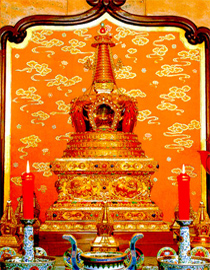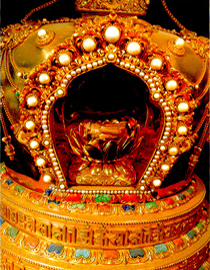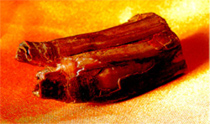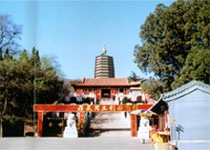



The Tooth Relic Pagoda is a new pagoda constructed by the Buddhists of China for the enthronement of a Holy Tooth of Shakyamuni Buddha. It is located at the original site of the Ling-guang Monastery, the second of the well-known eight scenic spots of the Western Hills in the suburbs of Beijing. This Holy Tooth was preserved in China for more than 1,500 years.
According to Buddhist historical records, after the Buddha's Nirvana, his body was cremated, and his two remaining teeth were discovered in the ashes. One of them was taken to Sri Lanka, the other one to the ancient kingdom of Udayana (in present Pakistan), and from Udyana it was brought to Kotan (present Hetian county of Xinjiang in China). During the 5th century, a Chinese monk from the Southern Qi dynasty named Fa-xian (424-498 A.D.) traveled to Khotan and brought the Holy Tooth back to Nanjing, which was then the Southern Qi capital.
Following the reunification of China under the Sui dynasty, the Holy Tooth Relic was sent to the new capital Chang-an. During the period of the Five Dynasties (when Central China fell into a chaotic state), the Tooth Relic was moved from place to place until it reached Yenjing (present-day Beijing) of the Liao dynasty in the North.
The "Chronicle of Emperor Dao-zong" in the History of the Liao Dynasty, Vol. XXII, contains a record relating the enshrinement of the Buddha's Tooth Relic in the Zhao-xian Pagoda in the 8th month of the 7th year of Xian-yong (1071 A.D.). This is how the Shakyamuni Buddha's Tooth Relic came to Beijing.
The Ling-guang Monastery, enclosing the Zhao-xian Pagoda, was founded in the 8th century; and the pagoda, which was an octagonal brick construction of ten stories, was built at the southeast corner of the premises. Because the bricks bore stamped images of Buddhas and pagodas, this pagoda was generally known as the "Pagoda with Images of One thousand Buddhas". The Ling-guang Monastery in Beijing was a famous place for tourists for several centuries. In 1900, the allied forces of eight imperialist counties invaded Beijing, and their atrocious acts of burning and plundering caused enormous destruction. Even though the Ling-guang Monastery and the Zhao-xian Pagoda were situated far away in the suburbs, they were, nevertheless, reduced to ruins with gun-fire.
After the war, when clearing the ruins, the monks from the monastery found in the basement of the pagoda a stone casket in which the Tooth Relic was preserved. In the casket there was a sandal wood box on which were written the words: "The Holy Tooth Relic of Shakyamuni Buddha, written by Shan-hui on the 23rd day of the 4th month in the 7th year of Tien-hui." Fortunately, the stone structure called "dew-basin", originally set on the top of the pagoda, still remains intact. The date of construction inscribed on it agrees with the record in the History of the Liao Dynasty.
The pagoda as recorded in the inscription on the "Dew Basin", was constructed by "The Lady of Yan-guo, nee Zheng, mother of the grand premier, (bearer of the titles of) Shang-fu, Ling-gong and the Duke of the Great Liao." This Lady of Yan-guo was the mother of Yelu Ren-xian, then the prime minister of Liao. Shan-hui, the inscriber of the wooden box, was a monk from the Northern Han dynasty during the time of the Five Dynasties, whose short biography is recorded in Mingho's Supplements to the Continued Biographies of Eminent Monks. The 7th year of Tien-hui, which was a reign-title of the Northern Han dynasty, fell in 963 A.D. The Northern Han was a pro-Liao and anti-Song war-lord regime ruling over the northern part of present Shanxi during the later period of the Five Dynasties, and was later subjugated by Song. From its interment in the Zhao-xian Pagoda in 1071 up to its reappearance in 1900, this Tooth Relic was preserved in the pagoda for 830 years. During the half century after the discovery of the Tooth Relic in 1900, China was under the reactionary rule of war-lords and bureaucrats, and suffered from the aggression of imperialism. The chaotic conditions of society made it impossible for the monks to worship the Holy Tooth Relic in accordance with Buddhist tradition. Initiated by the Buddhists of Beijing and supported by the People's Government, the Tooth Relic was brought to the Guang-ji Monastery in 1955. The Tooth Relic was enshrined in a golden stupa inlaid with seven kinds of jewels; the stupa is kept in the Sarira Pavilion for the worship of Buddhist devotees from China and from abroad. At the request of Buddhists from Burma and Sri Lanka, the Tooth Relic was taken on two different occasions to these countries, where it was worshipped by Buddhists as the real body and authentic presence of the Shakyamuni Buddha.
In 1957 the Buddhists of China decided to construct a new pagoda according to Chinese Buddhist tradition for the purpose of providing a sacred Buddhist pilgrimage site for the worship of the Holy Tooth, as well as for restoring the magnificence of this famous historical site. From the summer of 1958 till the spring of 1964, the construction work for the splendid new pagoda, including its accessory buildings, was completed.
With a height of 51 meters, the Tooth Relic Pagoda is an octagonal building decorated with thirteen layers and rests on a spacious platform 22 meters square and 2.70 meters above the ground. The Pagoda incorporates modern architectural techniques in structure while preserving the traditional style of classical Chinese Buddhist pagodas with minor modifications and developments. Externally, it takes the form of a single-story building with closely arranged layers, as was popular in north China during the Tang and Song dynasties. Covered with green tiles, crowned with a golden pinnacle and embellished with elaborately carved windows and beam-supporters, the whole structure creates an impression of simplicity, precision, dignity and elegance. Internally, it is divided into seven stories. The ground story includes a hidden chamber whose walls record the history of the construction of the pagoda and preserve the inscriptions of several Buddhist texts. Outside this chamber, a winding flight of stone steps leads up to the Tooth Relic Hall. In the middle of the hall stands a Vajra Throne on which is placed the golden stupa which enshrines the Holy Tooth; behind the stupa is a richly decorated brocade screen. The walls of the hall are inlaid with marble, and the ceiling is decorated with a carved coiling dragon brilliantly gilded against a vermilion background. The traditional setting and the sacred Holy Tooth produce a solemn and inspiring atmosphere. The six upper stories preserve (separately) Buddhist scriptures and religious ritual objects of the Chinese (Han), Tibetan, Mongolian and Tai lineages and traditions.
On June 25, 1964, the Buddhist Association of China solemnly performed the inauguration ceremony for the Tooth Relic Pagoda. Buddhist delegations from Cambodia, Sri Lanka, Indonesia, Japan, Laos, Mongolia, Nepal, Pakistan, Vietnam and Southern Vietnam were invited to attend the ceremony. Some foreign diplomatic envoys and Chinese officials also attended. The many foreign Buddhist delegations unanimously expressed their delight and appreciation for this significant historic Buddhist event, and sincerely prayed that the sacred Holy Tooth in the pagoda remain on this earth forever, always benefiting all sentient beings, bringing peace to the world and happiness to all people.